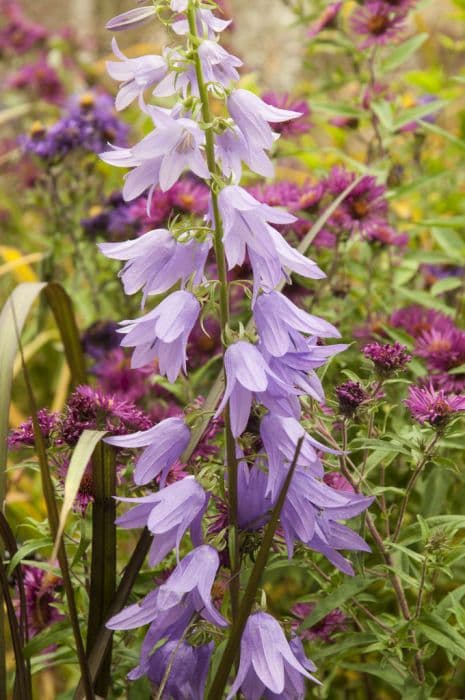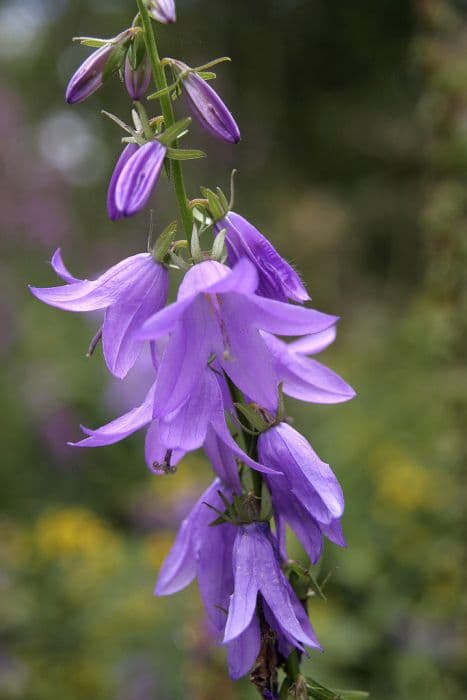Giant bellflower Campanula latifolia

ABOUT
Campanula latifolia, commonly known as the great bellflower or giant bellflower, is a perennial plant that is well-regarded for its striking and showy floral display. The plant has a robust and upright habit, with a clump-forming nature that allows it to spread comfortably in garden settings. The leaves of the great bellflower present a hearty appearance, being broadly lance-shaped to ovate, often with a heart-shaped base and a sharply pointed tip. They exhibit a lush, deep green hue and can grow to become quite large, with a coarse, hairy texture. Dominating the visual appeal of the great bellflower are its spectacular flowers. These blossoms, true to the plant's name, are shaped like wide-open bells and come in a variety of shades, mainly featuring deep violet to blue hues, but occasionally they may be found in lighter shades or even white. The inside of the bell is often adorned with delicate veins, adding to the intricate beauty of each flower. The florals form in impressive racemes, which are clusters that provide a lavish display of color during the blooming period. These bell-shaped flowers are organized neatly along the towering stems, which bear a simple elegance, granting the plant an almost regal presence in the garden. Encasing the blooms are small, green bracts that subtly compliment the flowers without overshadowing them. The great bellflower, when in full bloom, provides a breathtaking spectacle of vivid colors and stately form, making it a favorite among garden enthusiasts for its ornamental value and its ability to attract pollinators such as bees and butterflies to the garden. Despite the omission of its specific dimensions, it is clear that the great bellflower carries a presence that can enhance the beauty and biodiversity of any outdoor space.
About this plant
 Names
NamesFamily
Campanulaceae.
Synonyms
Giant Bellflower, Broad-leaved Bellflower, Large Campanula.
Common names
Campanula alpestris, Campanula caucasica, Campanula macrantha, Campanula macranthoides, Campanula persicifolia var. latifolia, Campanula pyramidalis var. caucasica, Campanula sibirica, Campanula speciosa, Campanula stenocodon, Campanula stevenii, Campanulastrum latifolium, Symphyandra latifolia.
 Toxicity
ToxicityTo humans
The Campanula latifolia, commonly known as the giant bellflower, is not generally considered toxic to humans. There are no well-known toxic effects from ingesting this plant. However, it's always advisable to exercise caution and avoid eating plants not typically recognized as food, as individual sensitivities can vary.
To pets
The Campanula latifolia, commonly known as the giant bellflower, is not generally considered toxic to pets. Symptoms of poisoning are not typically associated with the ingestion of this plant. Nonetheless, it's important to monitor pets for any unusual behavior or reactions when they have been in contact with garden plants, as individual animals might have different sensitivities.
 Characteristics
CharacteristicsLife cycle
Biennials
Foliage type
Deciduous
Color of leaves
Green
Flower color
Violet
Height
3-4 feet (0.9-1.2 meters)
Spread
1-2 feet (0.3-0.6 meters)
Plant type
Herb
Hardiness zones
3
Native area
Europe
Benefits
 General Benefits
General Benefits- Aesthetic Appeal: The Giant Bellflower, with its large bell-shaped flowers, adds beauty and visual interest to gardens and landscapes.
- Attracts Pollinators: It is known for attracting bees, butterflies, and other beneficial insects that support pollination.
- Versatility in the Garden: It can be used in a variety of garden designs, including borders, cottage gardens, and wildflower gardens.
- Easy to Grow: The plant is relatively easy to care for, making it suitable for novice gardeners.
- Perennial Growth: As a perennial, it comes back each year, providing long-term presence in the garden.
- Diversity of Colors: The Giant Bellflower comes in a range of colors, which can complement a variety of garden palettes.
- Shade Tolerance: It can grow in partially shaded areas, offering flexibility in garden placement.
 Medical Properties
Medical Properties- This plant is not used for medical purposes.
 Air-purifying Qualities
Air-purifying QualitiesThis plant is not specifically known for air purifying qualities.
 Other Uses
Other Uses- Campanula latifolia, commonly known as the giant bellflower, can be used as a natural dye for fabrics, imparting a range of shades including soft blues and grays.
- The flowers of the giant bellflower can be a decorative element in ice cubes or frozen into popsicles for an unusual, floral touch to beverages and frozen treats.
- Pressed or dried flowers of the giant bellflower can be used for crafting, specifically in decoupage or as additions to homemade paper, providing a distinctive aesthetic.
- The giant bellflower can be incorporated into a wildlife-friendly garden as it attracts pollinators like bees and butterflies, enhancing biodiversity.
- Leaves and stems of the giant bellflower, once dried, can be a component in potpourri, offering a subtle fragrance and adding visual interest.
- Campanula latifolia's sturdy stems can support lighter climbing plants in a mixed border or provide a natural backdrop to lower growing species in a garden bed.
- Artists may use the giant bellflower as a subject for botanical illustration or photography, capturing the elegance and detail of its structure.
- The bell-shaped flowers can be used as molds for crafting projects, such as making candle holders or decorative clay impressions.
- Seed pods from the giant bellflower can be collected and used in jewelry making, creating unique necklaces or earrings after proper drying and treatment.
- Fresh or dried blooms of Campanula latifolia can contribute to a natural confetti for celebrations, providing an eco-friendly alternative to synthetic confetti.
Interesting Facts
 Feng Shui
Feng ShuiThe Giant Bellflower is not used in Feng Shui practice.
 Zodiac Sign Compitability
Zodiac Sign CompitabilityThe Giant Bellflower is not used in astrology practice.
 Plant Symbolism
Plant Symbolism- Perseverance and endurance: The Giant Bellflower, as Campanula latifolia is commonly known, is a hardy plant that can thrive in challenging conditions. Its ability to grow in the wild symbolizes one's ability to endure hard times and persist despite obstacles.
- Constancy and fidelity: With its bell-shaped flowers that return year after year, the Giant Bellflower often represents unwavering loyalty and the faithfulness to return to loved ones or commitments.
- Humility: The bell shape of the flower, which hangs downwards, is often seen as a symbol of humility in its graceful posture, reminding one of the importance of modesty.
- Gratitude: The Giant Bellflower's abundant bloom can signify thankfulness, often used to express gratitude towards someone for their help or kindness.
- Attraction and romantic love: In the language of flowers, bell-shaped flowers like Campanula latifolia are also sometimes associated with attraction and unspoken, beautiful aspects of love.
 Water
WaterThe Giant Bellflower, commonly known as Campanula latifolia, should be watered deeply to ensure the soil is moist but not waterlogged. It typically needs water once a week, but during particularly dry or hot periods, watering frequency should increase to two to three times per week. A good rule of thumb is to provide about 1 to 1.5 gallons of water each time you water the plant, ensuring even distribution around the root zone. It's important to check the top inch of soil before watering; if it feels dry, it’s time to water your Giant Bellflower.
 Light
LightThe Giant Bellflower prefers partial shade to full sun conditions. It thrives best when it receives morning sunlight and is protected from the intense heat of the afternoon sun. An ideal spot is one with dappled sunlight or a location that offers some shelter from high midday temperatures, ensuring the plant receives at least six hours of sunlight a day.
 Temperature
TemperatureThe Giant Bellflower is hardy and can tolerate a wide range of temperatures, but it grows best in temperatures between 60°F and 70°F. It can survive minimum temperatures down to about -30°F, making it suitable for many temperate regions. However, during extremely hot weather, it’s important to provide some shade to prevent overheating, as temperatures consistently above 80°F may stress the plant.
 Pruning
PruningPruning the Giant Bellflower is essential to maintain its shape and encourage more blooms. Prune the plant in early spring to remove any dead or damaged stems and to shape the plant. After the initial flowering, cut back the spent flowers to promote a second bloom. Deadheading throughout the season will also improve the plant's appearance and vigor.
 Cleaning
CleaningNot needed
 Soil
SoilThe best soil mix for the Giant Bellflower, which is the common name for Campanula latifolia, is rich, well-draining soil with a pH of 6.0 to 8.0. An ideal mix can be made from equal parts of loamy garden soil, peat moss, and perlite or sand to ensure adequate drainage and fertility.
 Repotting
RepottingGiant Bellflowers need to be repotted every 1 to 2 years to replenish the soil and accommodate root growth. It's best to repot in spring just before the growing season begins for minimal stress on the plant.
 Humidity & Misting
Humidity & MistingThe Giant Bellflower thrives in average room humidity. It does not require any special humidity conditions, making it versatile for typical home environments around 40-60% relative humidity.
 Suitable locations
Suitable locationsIndoor
Place Giant Bellflower in bright, indirect light, and ensure good air circulation.
Outdoor
Plant in partial shade to full sun with moist, well-draining soil.
Hardiness zone
3-8 USDA.
 Life cycle
Life cycleThe life cycle of the Campanula latifolia, commonly known as the Giant bellflower, begins with seed dispersal, typically through wind or animal movement, after which the seeds germinate when conditions are favorable—adequate moisture, light, and temperature. Following germination, the plant enters a vegetative stage, developing a rosette of basal leaves and a root system. Over time, the Giant bellflower initiates a period of rapid growth, producing tall stems and lance-shaped leaves; this period may span over several years, as some plants can be biennial. Flowering usually occurs in the summer, with the plant producing characteristic large, bell-shaped blue or violet flowers, arranged in a spike or loosely branched cluster. After pollination by bees and other insects, seeds develop within the flowers' ovaries, and once mature, the seeds are released to start the cycle anew. Finally, the above-ground parts of the plant die back after seeding, with the plant surviving the winter as a rootstock or via the newly dispersed seeds.
 Propogation
PropogationPropogation time
Spring-Early Summer
Propogation: The Campanula latifolia, commonly known as the Giant bellflower, can be propagated through seed or division. The most popular way is by seed, which is typically sown in the spring after the threat of frost has passed. To propagate by seed, spread the seeds onto a well-draining soil mix and lightly press them into the surface. They need light to germinate, so they should not be covered with soil. The soil should be kept moist but not waterlogged. Seedlings will emerge in a few weeks and can be thinned out and transplanted to their final location when they're large enough to handle. This method allows for a higher quantity of new plants and maintains the species' genetic diversity.




![Trailing lobelia [Techno Heat Trailing Light Blue Improved]](/_next/image?url=https%3A%2F%2Fplants-admin.emdemapps.com%2Fimages%2Fplants%2F%2Fimages%2F604b65196de60.png&w=640&q=75)




